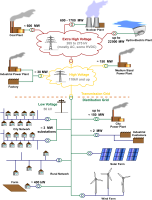
Photo from wikipedia
An integrated energy system (IES) shows great potential in reducing the terminal energy supply cost and improving energy efficiency, but the operation scheduling of an IES, especially integrated with inter-connected… Click to show full abstract
An integrated energy system (IES) shows great potential in reducing the terminal energy supply cost and improving energy efficiency, but the operation scheduling of an IES, especially integrated with inter-connected multiple energy stations, is rather complex since it is affected by various factors. Toward a comprehensive operation scheduling of multiple energy stations, in this paper, a day-ahead and intra-day collaborative operation model is proposed. The targeted IES consists of electricity, gas, and thermal systems. First, the energy flow and equipment composition of the IES are analyzed, and a detailed operation model of combined equipment and networks is established. Then, with the objective of minimizing the total expected operation cost, a robust optimization of day-ahead and intra-day scheduling for energy stations is constructed subject to equipment operation constraints, network constraints, and so on. The day-ahead operation provides start-up and shut-down scheduling of units, and in the operating day, the intra-day rolling operation optimizes the power output of equipment and demand response with newly evolved forecasting information. The photovoltaic (PV) uncertainty and electric load demand response are also incorporated into the optimization model. Eventually, with the piecewise linearization method, the formulated optimization model is converted to a mixed-integer linear programming model, which can be solved using off-the-shelf solvers. A case study on an IES with five energy stations verifies the effectiveness of the proposed day-ahead and intra-day collaborative robust operation strategy.
Journal Title: Energies
Year Published: 2021
Link to full text (if available)
Share on Social Media: Sign Up to like & get
recommendations!